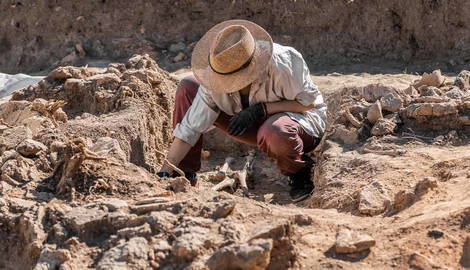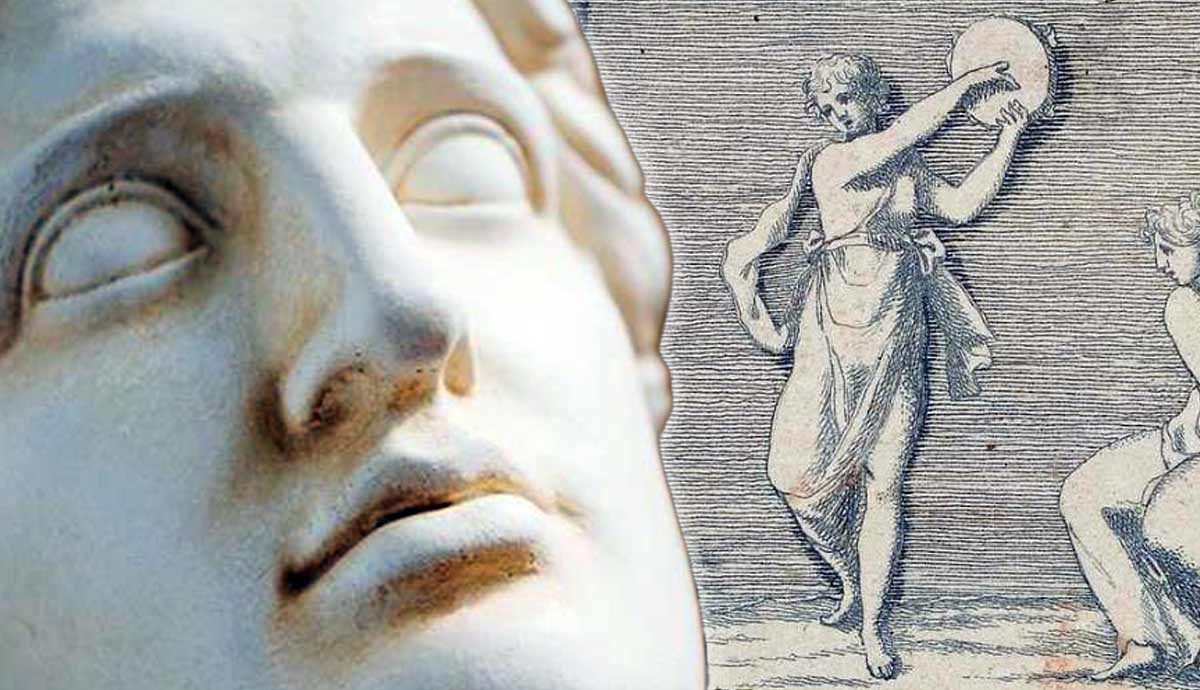
In Homer’s Odyssey, composed in the 7th century BCE, Odysseus is a king. As such, he obviously has a palace of sorts on Ithaca, his home island. Ithaca was a real place, as were most of the places described by Homer. However, does this mean that Homer was describing a real place when he referred to Odysseus’ palace? This is a question that archaeological research can help to clarify. Have archaeologists been able to find Odysseus’ palace on Ithaca, just as they were able to uncover Troy in the 19th century?
Did Archaeologists Discover Odysseus’ Palace in 2010?

In 2010, several news outlets reported the claim that archaeologists had discovered Odysseus’ palace on the island of Ithaca. However, this claim was associated with much confusion. For one thing, some articles claimed that the palace dated to the 8th century BCE, but this is not the traditional date of Odysseus’ reign, which is generally placed in the 13th or 12th century BCE, in line with the common belief about the date of the Trojan War.
Certain other sources claimed that the palace dated to the Mycenaean Era, which ended in c. 1150 BCE, but that there was also a spring dated to the 8th century BCE. Yet other sources claimed that both the site and the spring dated back to Mycenaean times. Clearly, there has been a lot of confusion surrounding this discovery. What are the facts regarding the archaeological discovery, and is there any reason for concluding that this really was the palace described by Homer?

The location in question is generally known as St Athanasios-School of Homer, although it is also known as Agios Athanasios, School of Homer. This is in the northern part of the island of Ithaca, between the villages of Platrithias and Exogi. Excavations occurred here between 1994 and 2012, led by archaeologists Thanasis Papadopoulos and Litsa Kontroli-Papadopoulou. What they found was a large complex of buildings in an acropolis arrangement. Habitation there started in the Middle Helladic Period, c. 1900-1600 BCE, and continued until at least as late as the Hellenistic Period, between the 4th and the 1st centuries BCE.
Therefore, this large building complex was inhabited during the Mycenaean Era, fitting the traditional date of Odysseus. What appears to have been a Mycenaean palace, a rectangular building with three sections measuring 21.5 by 11.5 meters, was also found. The spring was found to date from the Mycenaean era as well. As to why certain news outlets placed this site, or the spring, in the 8th century BCE, this presumably resulted from confusion with a common date for the Odyssey itself.
An Alternative Site for Odysseus’ Palace at Pilikata

While the archaeologists who worked on the site at Agios Athanasios did affirm that they believed that they had discovered Odysseus’ palace, other suggestions have also been made. One popular suggestion is that Pilikata, just north of the town of Stavros, was the site of the palace. Like the previous suggestion, this is in the northern half of Ithaca.
One reason why the northern half of Ithaca is a popular choice is that it is close to Polis Bay, on the western coast of the island. For good reason, Polis Bay has been identified as the harbor of Phorcys, where Odysseus arrived on Ithaca. Hence, it could seem logical to look for Odysseus’ palace close to where he arrived.
The archaeological site at Pilikata was excavated in the 1930s by the British School of Archaeology. What they found was that this was inhabited for many centuries prior to the era which forms the setting of the Odyssey. Its habitation continued down to Mycenaean times.

At Pilikata, the archaeologists who worked on the excavations found evidence of a walled pre-Hellenic settlement dating to before the Mycenaean Era. Various clay vessels were found buried underneath the floors of the houses. In more recent layers, the archaeologists found evidence of Mycenaean habitation. For this reason, many scholars over the decades have attempted to link this site to Odysseus’ legendary palace. However, it appears that nothing comparable to the grandeur of the apparent Mycenaean palace at Agios Athanasios has been found at Pilitika.
If Odysseus really should be dated to the Mycenaean Era, then it is important to note that both archaeological sites considered so far were inhabited in that era. Since Odysseus was the king of all of Ithaca and even several nearby islands, this is significant. This indicates that, out of the two sites, the former is clearly the more likely location for Odysseus’ home.
Odysseus’ Palace at Alalkomenes

However, when we look even further back in time, we find yet another site suggested as the home of Odysseus. In fact, it was the famous Heinrich Schliemann who argued that Odysseus’ palace can be identified with the archaeological site near Aetos. This is the site known as Alalkomenes, sometimes called Alalkomenes Castle. It is on the thin stretch of land connecting the northern and southern halves of Ithaca, close to the southern end.
Something that makes this an attractive suggestion for the site of Odysseus’ palace is the fact that it is in a strategic location. A king who ruled from this spot would be in an ideal location to control both halves of the island. He would be able to easily control travel between the two ends of Ithaca. Furthermore, this location would afford such a king excellent views of the channel between Ithaca and Cephalonia to the west, as well as the sea between Ithaca and the mainland to the east.

In many senses, this is the ideal location. However, what has archaeology actually found? Has it found traces of a palace that might have belonged to Odysseus? Something that is immediately obvious is that large, Cyclopean-style structures were present at this site. Numerous buildings were found in what was once a major settlement and a city wall surrounded it to an impressive height.
The oldest structure at Alalkomenes dates to c. 1400 BCE. This appears to have been a temple sanctuary. Furthermore, archaeologists have identified a definite sanctuary of Apollo near the main archaeological site, dating to the 10th century BCE. It would appear that the main settlement, excluding the Mycenaean sanctuary, dates to the Archaic Era. Some sources place its foundation in c. 750 BCE. This is long after the traditional era of Odysseus, which is why many scholars over the 20th century abandoned Alalkomenes as the probable site of Odysseus’ palace. However, the evidence for a Mycenaean sanctuary has inspired some hope again.
Which Site Has the Best Support?

Which site discovered by archaeologists has the best chance of really being the palace of Odysseus? This is profoundly dependent on the issue of when the Odyssey is actually set. While traditionally believed to be set in the Mycenaean Era, scholars today recognize that the Homeric poems are largely a reflection of the Archaic Era, Homer’s own time. For this reason, it is entirely possible that the historical figure who inspired Odysseus—if such a figure existed at all—lived more recently than in the Mycenaean Era. For instance, we should note that thirteen bronze tripods, exactly matching Odysseus’ treasure, were found at Polis Bay but were dated to the 8th century BCE.
This raises the possibility that Alalkomenes might have been the correct location after all. Notably, archaeologists have uncovered at this site several coins bearing inscriptions of Odysseus on them. While these date to centuries after Odysseus’ time, they may well indicate that this was viewed as the traditional home of the king. Furthermore, the Odyssey specifically mentions the worship of Apollo near Odysseus’ palace, which likewise fits in with Alalkomenes.
Possible Locations for Odysseus’ Palace According to Archaeology

In conclusion, have archaeologists discovered the true palace of Odysseus on Ithaca? Without a contemporary inscription specifically naming him, this will probably never be settled definitively. However, archaeology has certainly revealed a lot of useful information. If we place Odysseus in the Mycenaean Era, in c. 1200 BCE, then the relatively newly discovered palace at Agios Athanasios is almost certainly the right place. However, as some scholars have pointed out, there is reason to believe that Homer’s story may have been about a figure who lived in a more recent era. The evidence from the tripods very directly supports this conclusion.
With that likelihood in mind, it is entirely possible that the site of Alalkomenes further south is the correct site. Coinage evidence suggests that ancient tradition may have identified this as Odysseus’ home. Furthermore, archaeology has confirmed the presence of a sanctuary of Apollo there, which matches the Odyssey’s reference to the worship of Apollo nearby. Therefore, a good case can be made for Odysseus’ palace being at Alalkomenes if we accept a late date for the historical figure behind Homer’s story.










